中国气象学会主办。
文章信息
- 李海燕, 张文君, 何金海. 2016.
- LI Haiyan, ZHANG Wenjun, HE Jinhai. 2016.
- ENSO及其组合模态对中国东部各季节降水的影响
- Influences of ENSO and its combination mode on seasonal precipitation over eastern China
- 气象学报, 74(3): 322-334
- Acta Meteorologica Sinica, 74(3): 322-334.
- http://dx.doi.org/10.11676/qxxb2016.025
-
文章历史
- 2015-11-03 收稿
- 2016-02-29 改回
ENSO是热带太平洋大范围的海-气耦合现象,其发生不仅导致热带太平洋地区及其沿岸国家的气候异常,还能通过遥相关引起全球范围的气候异常(Bjerknes,1969; van Loon et al,1981;Ropelewski et al,1986,1987,1996;Wallace et al,1998;Trenberth et al,2000;Alexander et al,2002)。例如,ENSO发生时激发的太平洋-北美(PNA)遥相关型能影响到北太平洋及北美的气候异常(Hoskins et al,1981;Wallace et al,1981;Barnston et al,1987),ENSO也可以引起北大西洋和欧洲的气候异常(Brönnimann,2007;Ineson et al,2009;Zhang et al,2014a)。正因为ENSO广泛而深刻的气候学意义,科学家们对其展开了持续的探讨,最近几十年,关于ENSO现象特征、机理和预测等问题取得了较大的进展(Wyrtki,1975;Suarez et al,1988;Battisti et al,1989;Jin,1997a,1997b;Picaut et al,1997;Weisberg et al,1997;Neelin et al,1998;巢纪平,1993;严邦良等,2002),加深了对ENSO现象及本质的认知。
中国东部濒临西太平洋,其气候异常与ENSO关系密切(Huang et al,1989;Zhang et al,1996;Wang et al,2000,2013a;Wu R G et al,2003;Lau et al,2006,2009;Wu Z W et al,2009;Zhang et al,2014b;刘永强等,1995;陶诗言等,1998;金祖辉等,1999)。符淙斌等(1988)研究指出,厄尔尼诺对中国气候的影响依赖于其位相。后来的研究也表明,厄尔尼诺发展年夏季,华南和华北降水偏少,而江淮流域降水偏多(Huang et al,1989);厄尔尼诺年冬季,中国东南部出现正降水距平(Gong et al,1999);厄尔尼诺衰减年的春末夏初,从中国华南到东北延伸到日本南部出现正的异常降水(Zhang et al,1996;Wang et al,2000)。这种与厄尔尼诺相关的中国各季节降水异常主要是由于西北太平洋异常反气旋的作用(Harrison et al,1996;Zhang et al,1996;Wang et al,2000),该异常反气旋通常始于ENSO成熟期的秋冬季,并于次年春季达到峰值(Harrison et al,1996;Wang et al,2000,2002,2013a)。以往研究提出了一些可能的物理机制来解释厄尔尼诺影响西北太平洋反气旋异常的途径。Zhang等(1996)指出,厄尔尼诺期间西北太平洋大气异常是由于沃克环流减弱引起赤道西太平洋对流偏弱的作用;Wang等(2000)认为,西北太平洋反气旋异常是对西太平洋冷海温的响应,该异常反气旋通过风场与异常海温的正反馈过程一直维持到ENSO峰值之后的初夏(风-蒸发-海温正反馈)。此外,Yang等(2007)和Xie等(2009)指出,厄尔尼诺峰值之后的印度洋延迟变暖对衰减年西北太平洋异常反气旋起到重要作用,印度洋的延迟变暖会引起赤道东风异常,并通过斜压大气开尔文波响应抑制西北太平洋对流,从而建立反气旋异常。但是,有研究指出,印度洋延迟变暖无法解释对称开尔文波作用下西太平洋大气响应的不对称性现象(Stuecker et al,2015)。目前,厄尔尼诺影响西北太平洋反气旋的物理机理仍存在着较大的争议。
最近研究发现,发生在赤道太平洋地区的ENSO年际变率与年循环存在着非线性相互作用,这不同于ENSO的自身模态,被称为ENSO组合模态(McGregor et al,2012,2013; Stuecker et al,2013)。该组合模态的风场特征表现为在厄尔尼诺衰减阶段中太平洋低层纬向西风异常南移及西北太平洋强的反气旋性环流的建立。这种大气响应的经向反对称结构主要与西太平洋暖池随太阳辐射的季节性南移有关(Harrison,1987;Harrison et al,1998,1999;Vecchi et al,2003,2006;Spencer,2004;Lengaigne et al,2006;Ohba et al,2009;李海燕等,2016)。西北太平洋反气旋异常是ENSO组合模态的重要组成部分,该异常反气旋能将更多的水汽输送到东亚大陆(Zhang et al,1996;Wang et al,2000;McGregor et al,2012;Stuecker et al,2013)。目前,ENSO组合模态如何影响东亚气候异常尚不清楚,对东亚尤其中国降水异常的贡献如何亦未被关注,因此,有必要加强ENSO组合模态对东亚气候异常贡献的研究,以便加深理解与ENSO相关的东亚降水机制,为提高东亚降水季节预测提供重要的科学依据。本研究旨在进一步探索ENSO模态及其与年循环相互作用的组合模态对中国东部各季节降水的影响。主要讨论与ENSO相关的中国东部各季节降水与这两种不同ENSO模态之间的关系,以了解东部各季节降水影响机理的差异。
2 资料和方法所用海温资料为英国哈得来中心提供的月平均海表温度(HadISST)资料(Rayner et al,2003),水平分辨率为1°×1°;其他气象要素来自欧洲中期天气预报中心(ECWMF)的ERA-40月平均资料(Simmons et al,2000),水平分辨率是2.5°×2.5°;同时也用了美国国家大气研究中心提供的NCEP/NCAR再分析资料(Kalnay et al,1996),结果基本一致;降水资料为中国气象局提供的160站逐月降水量资料。所有资料皆取1961年1月—2001年12月。
2000年以来,发生的厄尔尼诺事件基本上为位于赤道中太平洋日界线附近的新一类厄尔尼诺事件(Larkin et al,2005;Ashok et al,2007;Kao et al,2009;Kug et al,2009;Ren et al,2011),这类厄尔尼诺事件对东亚气候的影响与传统型厄尔尼诺事件存在显著差异,主要是因为两类厄尔尼诺事件对西北太平洋大气环流影响的不同(Feng et al,2010,2011,Zhang et al,2011,2012,2013,2014a;Xie et al,2012;Yuan et al,2012;Wang et al,2013b;陈圣劼等,2013)。尽管1961—2001年也存在中部型的厄尔尼诺事件(Xu et al,2013),但发生次数较少,2000年前的厄尔尼诺是以传统厄尔尼诺为主。为了避免这类新厄尔尼诺事件的不同大气响应的干扰,文中选取的气象要素场为1961—2001年,即主要分析传统厄尔尼诺事件对中国东部各季节降水的影响。同时,也检查了较长的时段(1961—2012年),尽管结果存在一些小的差异,但是定性结论不变。
采用美国海洋大气局(NOAA)气候预测中心(CPC)公布的冬季Nino3.4(5°N—5°S,120°—170°W)指数筛选1961—2001年强厄尔尼诺事件。共选出7次强的厄尔尼诺事件,即1965/1966、1968/1969、1972/1973、1982/1983、1986/1987、1991/1992、1997/1998年。值得注意的是,本研究也挑选出了这期间所有厄尔尼诺事件进行分析,其定性结果一致。其中,气候态取1961—2001年各月平均值。文中SON(0)、DJF(0)、MAM(1)分别代表厄尔尼诺发展年的秋季、冬季及衰减年春季,其他月份类同。没有分析厄尔尼诺次年东部夏季降水异常,主要是由于夏季降水受到太多因素的影响,而此时厄尔尼诺信号最弱,因此,暂不分析夏季的情况。
在分析ENSO模态及其相关的ENSO组合模态对中国东部各季节降水的影响时,主要用到的方法有合成、回归以及偏回归法。其中,偏回归是为了消除另一模态变量的影响,用偏回归相关系数乘以变量自身的方差。两个模态对降水的方差贡献是降水异常与各代表指数相关系数的平方(R2)。尽管厄尔尼诺与拉尼娜对中国降水的影响存在不对称性,例如,Zhang等(2015)研究指出中国华南地区厄尔尼诺年的冬半年出现显著的降水异常,但是拉尼娜时负降水距平并不显著,主要原因是西北太平洋低层大气环流的不对称性造成的,但文中对降水贡献的衡量主要通过线性的方法来尝试研究两个模态对各季节降水的方差贡献,而关于对厄尔尼诺与拉尼娜对中国降水影响的非对称性暂未考虑。所有的统计都进行t检验。为了去掉年代际变率的可能影响,凸出年际变率,首先去掉了所有资料的趋势;然后,利用Lanczos滤波器对各物理场进行6—120月带通滤波。同时也计算了未滤波的结果,其结果几乎没有变化。
3 两种ENSO模态的时空演变特征对赤道太平洋地区(10°S—10°N,100°E—80°W)的表面风场进行经验正交函数分析,可以得到ENSO和ENSO组合模态相关风场的时空演变特征(图 1)。可见经验正交函数分解第一和第二模态方差贡献分别为32%和17.2%,根据North判别准则(North et al,1982),这两个特征向量具有相对独立性。前两个特征向量方差的总贡献率接近50%,能够表征赤道太平洋地区表面风场主要特征。从经验正交函数分解第一模态的风场空间分布(图 1a)可见,赤道中太平洋地区呈现显著西风异常,相对赤道成经向对称分布,印度洋地区为显著的东风异常。这种风场异常分布反映了典型的厄尔尼诺风场响应结构。此外,经验正交函数分解第一模态的时间系数(记为PC1)存在显著的年际变化特征,每一个峰值都对应着一次厄尔尼诺事件,PC1与Nino3.4指数呈现出高度的一致性,其相关系数高达0.86。因此,不论从风场异常的空间分布还是从其时间变率来说,都表明经验正交函数分解第一模态表征了ENSO模态。
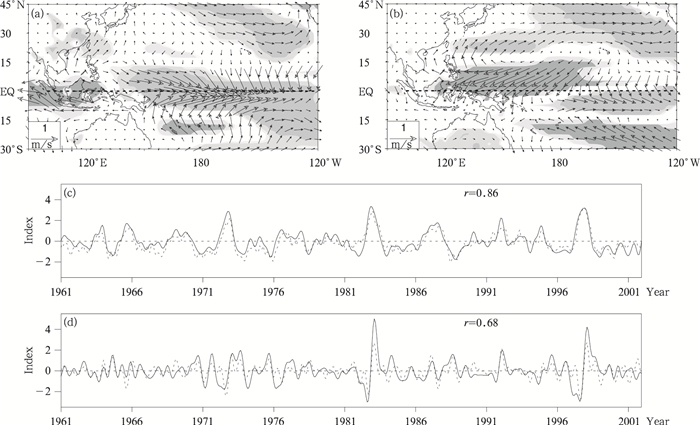 |
| 图 1 (a)1961—2001年热带太平洋地区(10°S—10°N,120°E—90°W)表面风场经验正交函数分解第一模态时间系数回归的风场空间型;(b)同(a),但为第二模态(浅色和深色阴影区分别表示异常西风通过90%、95%显著性检验);(c)PC1(实线)、Nino3.4(虚线)指数的时间演变;(d)PC2(实线)、PC2_simp(虚线)指数的时间演变 Fig. 1 (a) The EOF1 associated spatial pattern of surface wind anomalies regressed against the time coefficient of the normalized PC1 over tropical Pacific (10°S-10°N,120°E-90°W) during 1961-2001. (b) Same as (a), but for EOF2 (light and dark shaded areas indicate the zonal wind anomalies are statistically significant at 90% and 95% confidence level, respectively). (c) Time series of PC1 (solided line) and Nino3.4 (dotted line) index, and (d) time series of PC2 (solided line) and PC2_simp (dotted line) index |
与经验正交函数分解第一模态明显不同,第二模态的异常风场在赤道两侧几乎成反对称的结构(图 1b),表现为西北太平洋和东南太平洋的两个异常反气旋的风切变结构,这种风场异常结构对应着ENSO组合模态的风场特征(Stuecker et al,2013)。该模态本质上是ENSO变率与背景海表温度(SST)年循环相互作用的结果,其存在着两个显著的主周期(约8和15个月)(图略)。为了进一步揭示ENSO组合模态的本质,利用可表征ENSO年际变率的PC1和表征背景海温年循环的余弦函数cos(wt+φ)重建了一个新的时间序列PC2_simp,通过PC2_simp与PC2的相关性分析,检验PC2的物理意义。定义PC2_simp=PC1×cos(wt+φ),ω为背景海温年循环频率,这里取2π/12,φ为年循环的位相,此定义清晰地表明PC2_simp完全决定于海温年循环和ENSO变率相互作用的结果。PC2_simp与PC2相关系数高达0.68(图 1d),通过了99%的显著性检验,说明经验正交函数分解第二模态是ENSO变率与海温年循环相互作用的组合模态,此结论与已有研究结果一致(Stuecker et al,2013)。
图 2给出了厄尔尼诺事件合成的两种模态(PC1、PC2)季节演变。PC1表现出典型厄尔尼诺事件的季节演变特征,即在春、夏季发生,在秋、冬季达到成熟,并在次年春季衰减。区别于PC1,PC2在厄尔尼诺发展年的10月仍然为负值,之后在12月迅速转为正值,在晚冬和早春达到峰值,并且在厄尔尼诺成熟之后的次年夏季进入衰减阶段。其峰值相对PC1约延迟3个月,且具有相对短的周期。
 |
| 图 2 1961—2001年厄尔尼诺事件合成的PC1(实线)和PC2(虚线)的季节演变(横坐标表示厄尔尼诺 当年1月至次年12月) Fig. 2 Composite seasonal evolutions of PC1 (solided line) and PC2 (dotted line) for El Nio events during the period of 1961-2001 (The abscissa indicates a 24 month period from January of year 0 to December of year 1) |
由前面分析可见,尽管ENSO组合模态是由ENSO信号导致产生的,但其与ENSO模态的季节演变存在显著的差异,那么它们对中国东部各季节降水的贡献是否有所不同?为了回答这一问题,首先给出了厄尔尼诺事件合成的中国东部各季节降水异常的空间分布情况。由图 3可见,厄尔尼诺年秋季,显著的降水异常区主要分布于西南和长江及华南大部分区域,最大异常值为25 mm/月。相对秋季而言,冬季的降水正距平范围明显增大,强度增强,表现为异常区向北部扩展,其中通过显著性检验的区域覆盖华南、华东及华北东南部地区,最大中心强度达到35 mm/月。次年春季,降水正距平区主要位于35°N以南、110°E以东,高值中心位于东南沿海及长江下游,中心最大强度为35 mm/月。由此可见,厄尔尼诺引起的中国东部降水异常在不同季节均增多,不同之处在于异常中心的季节性变化较大。秋季大值中心位于西南部,冬季中心东移至华南,次年春季则集中在华南沿海及长江下游。厄尔尼诺成熟期与衰减期中国东部各季节降水型与已有研究结果(Zhang et al,1999;Wang et al,2000,2002;Wu R G et al,2003)基本一致。
 |
|
图 3 1961—2001年厄尔尼诺事件合成的各季节降水异常(单位:mm/月) (a、b、c.厄尔尼诺当年秋季、冬季、次年春季;浅色和深色阴影区分别表示通过80%和90%的信度检验) Fig. 3 Composite seasonal precipitation anomalies (unit:mm/month) during El Nio events over the period of 1961-2001: (a) SON and (b) DJF during El Nio year, and (c) MAM during the next year (Light (dark) shaded area indicates the values exceed the 80% (90%) confidence level) |
为了较深入分析ENSO模态对中国东部降水的影响,给出了当年秋季、冬季及次年春季平均PC1对中国东部降水异常的回归和偏回归空间分布型(图 4)。需要指出的是,PC1偏回归分析结果是去除同期的PC2影响后的降水异常。可见秋季异常降水回归场的空间型(图 4a)与合成场分布(图 3a)基本一致,即西南及长江中下游出现显著的正降水异常;此外,偏回归的降水异常分布(图 4d)与回归场(图 4a)尽管影响区域有所减小,但总体而言表现出了一致特征,说明当年秋季异常降水主要受ENSO模态的影响,受ENSO组合模态的影响较小。冬季,正降水异常主要集中在华南及江淮流域,与降水异常合成场一致(图 3b),并且,去掉同期PC2影响后的偏回归异常降水显著信号也几乎一致(图 4e),说明冬季降水异常也主要受ENSO模态的影响。春季,回归场与合成场(图 3c)有显著差异,范围和强度都变小,只是在华南南部与合成降水异常类似,但是去掉春季ENSO组合模态影响之后中国南部正降水异常消失(图 4f),说明ENSO模态本身并不能导致中国南部春季降水异常。综上,ENSO模态本身能够导致中国东部当年秋季及冬季降水增多,但是对于次年春季,ENSO模态本身不能够导致中国东部尤其是华南南部的降水增多。
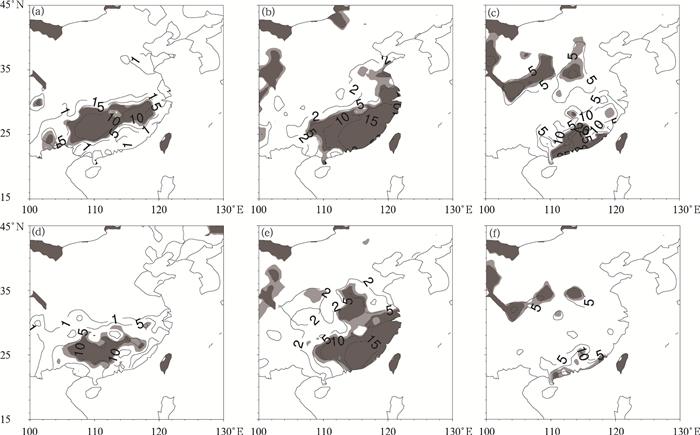 |
|
图 4 1961—2001年当年秋季(a)、冬季(b)及次年春季(c)平均PC1对同期中国东部降水的回归场; (d、e、f)同(a、b、c),但为去掉同期的PC2指数影响以后的偏回归场(单位:mm/月,阴影区为通过90%、95%显著性检验) Fig. 4 Simultaneously regressed precipitation anomalies (unit: mm/momth) against PC1 over eastern China during (a) SON and (b) DJF of El Nio year; (c) MAM during the following year; (d、e、f) same as (a、b、c), but for the partially regression by removing the PC2 signal (Light and dark shaded areas indicate the value exceeds the 90% and 95% confidence level, respectively) |
为了表证ENSO组合模态与中国东部各季节降水的关系,类似图 4,给出了当年秋季、冬季及次年春季平均的PC2回归和偏回归的中国东部降水异常分布型(图 5)。结果表明,当年秋季,PC2回归的降水异常除了在中国的中北部(35°N,105°E附近),几乎没有信号(图 5a)。去掉PC1影响的偏回归场不管在中北部还是东部都没有显著的降水异常(图 5d),说明ENSO组合模态对中国东部秋季降水没有显著影响。冬季,虽然PC2回归场在华南地区存在显著正降水异常,但是去掉同期PC1的影响后的偏回归场分布,该正异常信号消失,说明ENSO组合模态对中国冬季降水的影响几乎可以忽略(图 5b、e)。次年春季,回归场在华南地区存在强的异常降水,中心达到20 mm/月;去掉同期PC1影响后的偏回归正降水异常与去掉之前一致,说明春季南方降水主要受ENSO组合模态的影响,ENSO模态对其几乎没有影响(图 5c、f)。通过回归与偏回归分析发现,ENSO年,中国东部当年秋季及冬季降水异常主要受ENSO本身模态的影响,但是次年春季降水异常主要与ENSO组合模态有关。
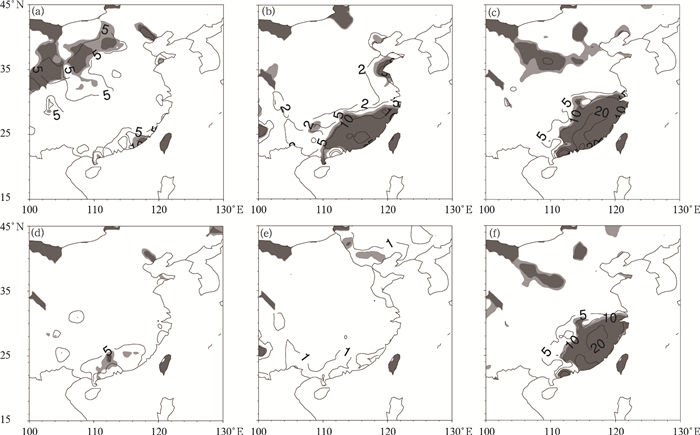 |
| 图 5 同图 4,但为PC2的结果,并且偏回归为去掉同期PC1的影响 Fig. 5 Same as Figure 4, but for PC2, the partially regression by removing the PC1 signal |
为了进一步证实上述回归和偏回归的结论,通过两个模态对东部各季节降水的方差贡献的对比(图 6)发现,秋季,PC1的方差贡献(图 6a)主要集中在西南地区,中心达到25%左右,而加入PC2后的方差贡献与PC1单独的贡献基本一致(图 6b),二者的差值场小于5%(图 6c),表明秋季降水异常主要是PC1的贡献。冬季,PC1对南方地区异常降水的方差贡献都在20%以上,中心最大值达到40%(图 6d),PC1与PC2同时作用时的方差贡献几乎没有提高(图 6e),差值场接近0值(图 6f),说明冬季主要还是PC1的贡献,PC2贡献不大。春季,PC1的方差贡献很小,只有零星的信号(图 6g),但加入PC2后的方差贡献明显提高,中心最大值达到30%(图 6h),说明春季降水主要受PC2影响。再一次说明了ENSO年秋冬季的中国南方降水异常主要受ENSO自身信号的影响,而次年春季的降水异常主要受ENSO与年循环相互作用的组合模态的影响。
 |
| 图 6 (a)秋季平均的PC1与同期降水异常的方差贡献分布,(b)秋季平均的PC1与PC2同时作用时的方差贡献分布,(c)为(b)与(a)之差;(d、e、f)同(a、b、c)但为冬季平均;(g、h、i)同(a、b、c)但为次年春季平均(等值线分别为:10,20,30,40) Fig. 6 The variance of SON precipitation over East China accounted by the simultaneous PC1 (a), by both the simultaneous PC1 and PC2 (b), and their difference (c).(d, e, f) Same as (a, b, c), but for DJF.(g, h, i) Same as (a, b, c), but for MAM during the following year (The contour lines correspond to 10, 20, 30, and 40) |
由于两种ENSO模态对中国东部降水异常的影响存在差异性的区域主要集中在中国南方(图 4—6),进一步给出了仅考虑PC1作用,以及同时考虑PC1和PC2作用时南方地区(23°—28°N,105°—120°E)的降水异常方差贡献率。由表 1可见,秋季,单独PC1的区域平均的方差贡献为23.8%,将PC2加进来以后方差贡献为25.7%,相比于PC1,PC2的贡献几乎可以忽略。冬季,PC1的方差贡献为31.9%,PC1与PC2同时作用的贡献为32.8%,显然冬季还是PC1的贡献为主。次年春季,PC1的方差贡献只为7%,但是将PC2加进来以后的贡献提高到21.9%,说明春季降水的异常主要受PC2的影响。
| PC1 | PC1+PC2 | |
| SON | 23.8 | 25.7 |
| DJF | 31.9 | 32.8 |
| MAM | 7 | 21.9 |
降水异常的出现与大气环流场密切相关。因此,诊断水汽输送环流异常的变化,将有助于理解ENSO两个模态与中国东部降水异常的内在联系与可能机制。图 7给出了PC1和PC2偏回归得到的整层水汽输送通量和散度异常分布。秋季,从PC1偏回归的水汽输送和散度分布中可以看出,在赤道地区有一个向东的水汽输送,导致赤道中东太平洋出现强的辐合中心,水汽输送异常主要是由于厄尔尼诺期间赤道中太平洋西风异常引起的(图 1a),西北太平洋地区存在反气旋性水汽输送(图 7a),使得更多的水汽往中国南方地区输送,导致降水增多(图 2a)。相对于PC1,PC2秋季偏回归的环流场,西北太平洋地区没有显著的环流异常(图 7d),进一步说明秋季异常降水与组合模态关系较小。冬季,ENSO模态异常场与秋季的水汽输送异常场类似(图 7b),只是随着厄尔尼诺进入成熟期相应的强度有所增强;而组合模态主要表现为赤道地区向西的水汽输送异常,说明冬季东部的水汽来源仍与ENSO组合模态关系不大(图 7e)。春季,ENSO模态,表现为赤道中太平洋水汽存在向东太平洋输送(图 7c),在没有出现显著的水汽输送异常,对中国降水影响较弱;而ENSO组合模态在西北太平洋地区存在强的反气旋水汽输送,向东亚地区输送大量的水汽(图 7f),使得中国南方降水偏多(图 2c)。
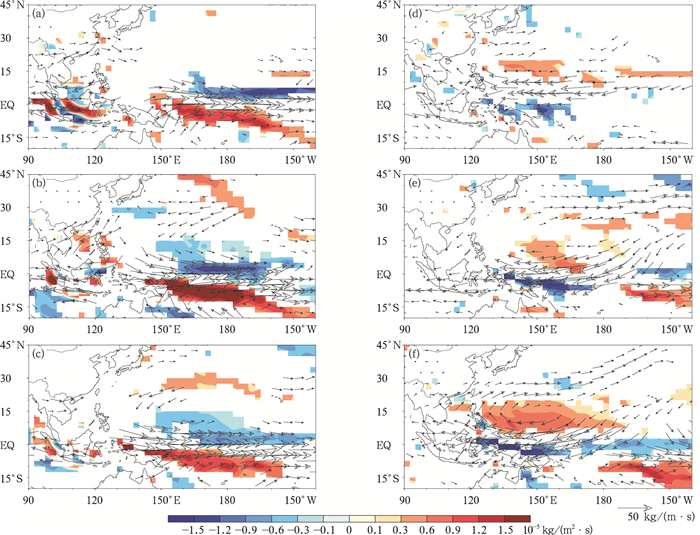 |
| 图 7 1961—2001年当年秋季(a)、冬季(b)及次年春季(c)平均的PC1偏回归的水汽通量距平场(矢量, 1000—300 hPa,且通过90%显著性检验)和辐散分量散度距平(色阶,且通过90%显著性检验); (d、e、f)同(a、b、c),但为同期PC2的偏回归场 Fig. 7 Seasonal mean vertically integrated moisture transport anomalies (vectors) and its divergence anomalies (shading) partially regressed upon PC1 during 1961-2001: (a) SON and (b) DJF of El Nio year, (c) MAM of the following year, (d, e, f) same as (a, b, c), but for partial regression against PC2. (Vertical integration is performed from 1000 to 300 hPa. Only values that exceed the 90% confidence level are shown) |
强的上升运动对降水至关重要。图 8给出了PC1、PC2沿110°—120°E平均的偏回归经向环流异常场。对于ENSO模态,秋季在20°—30°N有显著的上升气流,向上伸展到300 hPa(图 8a),有利于东部降水异常偏多;而ENSO组合模态在北半球基本上没有上升运动。冬季,PC1偏回归的垂直环流,在中国南方地区有强的上升气流活动,增强了华南地区的辐合上升,有利于降水形成; ENSO组合模态与秋季类似,在南方地区没有显著的上升运动。次年春季,ENSO模态在中国东部没有显著的上升气流,反而是有弱的下沉气流;对应ENSO组合模态,华南有明显的上升气流,这能直接导致次年春季多雨。垂直环流场与上述分析结果一致。
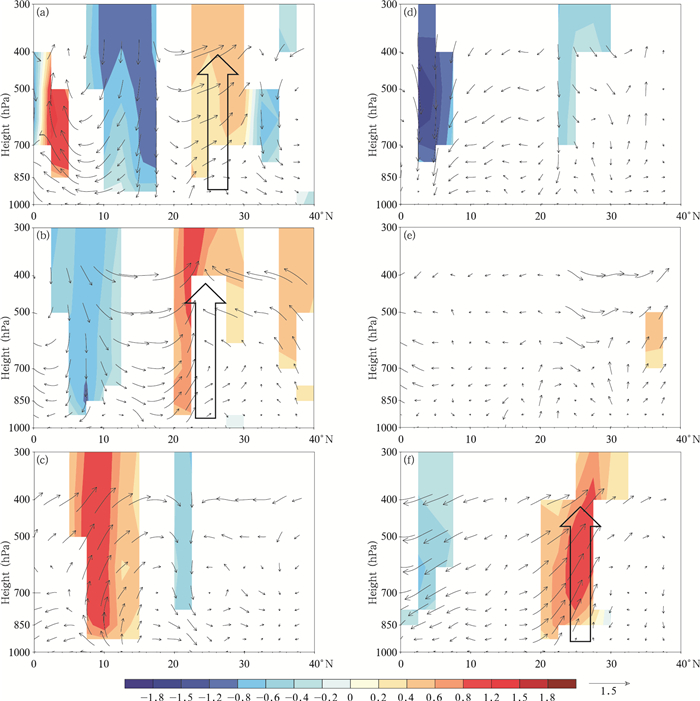 |
| 图 8 1961—2001年当年秋季(a)、冬季(b)及次年春季(c)平均的PC1偏回归同期的110°—120°E 平均垂直环流(单位:0.01 Pa/s;填色为通过90%显著性检验的垂直速度),(d、e、f)同(a、b、c),但为同期PC2的偏回归场 Fig. 8 Seasonal mean vertical circulation (contours in 0.01 Pa/s) averaged over 110-120°E through 1961-2001 partially regressed upon PC1 for (a) SON and (b) DJF of El Nio year, (c) MAM of the following year, (d, e, f) same as (a, b, c), but for partial regression against PC2 (Shaded areas indicate positive and negative partial correlation coefficients that exceed the 90% confidence level) |
综上可见,厄尔尼诺年秋季,中国东部降水异常主要受ENSO模态的影响,由于西北太平洋对ENSO模态的大气响应出现了反气旋性环流的水汽输送,即ENSO模态本身的海温强迫使得西北太平洋地区出现反气旋性环流,导致中国东部降水增多。冬季,中国东部正降水异常主要也是ENSO模态的贡献。次年春季,ENSO变率本身并不能对中国东部降水产生显著的影响,而是通过与海温年循环的相互作用,把ENSO赤道上的信号扩展到赤道外地区,从而影响到中国东部降水。因此,次年春季ENSO对中国降水的影响是通过与西太平洋暖池海温年循环的相互作用的ENSO组合模态作用而产生。
6 结论利用哈得来中心逐月海表温度、欧洲中期天气预报中心ERA-40的10 m风场、NCEP/NCAR再分析资料及中国气象局的160站逐月降水资料,探讨了ENSO模态与ENSO组合模态对中国东部各季节降水的影响。结果表明,厄尔尼诺年秋季,中国西南、长江及华南大部分区域呈现显著正降水异常;冬季,正降水异常范围扩大,覆盖华南、华东及华北东南部地区。这两个季节的异常降水都主要受ENSO模态的影响,该模态对两个季节南方区域平均的方差贡献分别达24%、32%。其主要机制可能是由于与ENSO模态相关的正异常海温局地强迫导致了在120°E以西出现的反气旋性环流,该异常反气旋的西北侧向中国输送大量的暖湿气流,有利于中国东部地区降水增多。次年春季,从中国华南延伸到东北出现正的异常降水,主要是ENSO组合模态的贡献。在次年春季热带太平洋地区纯ENSO模态信号只局限于赤道地区,并没有对中国东部降水有显著的影响,而海温年循环与ENSO的相互作用的组合模态使得与ENSO相关的赤道大气异常可以扩展到赤道以外地区,即西北太平洋低层出现大范围的强异常反气旋,其中心约在150°E,相比于秋冬季其中心出现强烈的东移,此异常有利于中国东部正异常降水的出现。可见,ENSO一方面通过直接影响热带的大气环流进而影响东亚的降水,另一方面,通过与年循环相互作用间接地影响东亚大气环流。ENSO组合模态对东亚的气候影响在以往的研究中被忽略了,本研究结果表明ENSO组合模态的作用是不容忽略的。对ENSO组合模态的研究加深和完善了人们对与ENSO相关的中国降水异常机制的认识,对提高东亚气候预测有重要的科学价值和指导意义。
致 谢:感谢祁丽教授对本文提出了很有意义的修改意见,同时感谢耿新博士提出的修改意见及对本文进行的详细校对。
| 巢纪平. 1993. 厄尔尼诺和南方涛动动力学. 北京:气象出版社, 2-3. Chao J P. 1993. El Niño and Southern Oscillation Dynamics. Beijing:China Meteorological Press, 2-3(in Chinese) |
| 陈圣劼, 何金海, 吴志伟. 2013. 一种新的El Niño海气耦合指数. 大气科学, 37(4):815-828. Chen S J, He J H, Wu Z W. 2013. A new ocean atmosphere coupling index for El Niño. Chinese J Atmos Sci, 37(4):815-828(in Chinese) |
| 符淙斌, 腾星林. 1988. 我国夏季的气候异常与厄尔尼诺/南方涛动现象的关系. 大气科学, 12(特刊):133-141. Fu C B, Teng X L. Climate anomalies in the summer in China associated with El Niño/Southern Oscillation. Scientia Atmos Sinica, 12(S):133-141(in Chinese) |
| 金祖辉, 陶诗言. 1999. ENSO循环与中国东部地区夏季和冬季降水关系的研究. 大气科学, 23(6):664-672. Jin Z H, Tao S Y. 1999. A study on the relationship between ENSO cycle and rainfall during the summer and winter in eastern China. Chinese J Atmos Sci, 23(6):664-672(in Chinese) |
| 李海燕, 张文君, 何金海等. 2016. SST年循环对El Niño事件局地海气过程的影响. 海洋学报, 38(1):56-68. Li H Y, Zhang W J, He J H, et al. 2016. Influences of annual SST cycle on local air-sea processes during El Niño events. Acta Oceanol Sinica, 38(1):56-68(in Chinese) |
| 刘永强, 丁一汇. 1995. ENSO事件对我国季节降水和温度的影响. 大气科学, 19(2):200-208. Liu Y Q, Ding Y H. 1995. Reappraisal of the influence of ENSO events on seasonal precipitation and temperature in China. Scientia Atmos Sinica, 19(2):200-208(in Chinese) |
| 陶诗言, 张庆云. 1998. 亚洲冬夏季风对ENSO事件的响应. 大气科学, 22(4):399-407. Tao S Y, Zhang Q Y. 1998. The response of the Asian winter and summer monsoon to ENSO. Scientia Atmos Sinica, 22(4):399-407(in Chinese) |
| 严邦良, 张人禾. 2002. 热带西太平洋风应力异常在ENSO循环中作用的数值试验. 大气科学, 26(3):316-329. Yan B L, Zhang R H. 2002. A numerical experiment of the effects of wind anomaly over equatorial western Pacific on ENSO cycle. Chinese J Atmos Sci, 26(3):316-329(in Chinese) |
| Alexander M A, Bladé I, Newman M, et al. 2002. The atmospheric bridge:The influence of the ENSO teleconnections on air-sea interaction over the global oceans. J Climate, 15(16):2205-2231 |
| Ashok K, Behera S K, Rao S A, et al. 2007. El Niño Modoki and its possible teleconnection. J Geophys Res, 112(C11):C11007, doi:10.1029/2006JC003798 |
| Barnston A G, Livezey R E. 1987. Classification, seasonality and persistence of low-frequency atmospheric circulation patterns. Mon Wea Rev, 115(6):1083-1126 |
| Battisti D S, Hirst A C. 1989. Interannual variability in a tropical atmosphere-ocean model:Influence of the basic state, ocean geometry, and nonlinearity. J Atmos Sci, 46(12):1687-1712 |
| Bjerknes J. 1969. Atmospheric teleconnections from the equatorial Pacific. Mon Wea Rev, 97(3):163-172 |
| Brönnimann S. 2007. Impact of El Niño-Southern Oscillation on European climate. Rev Geophys, 45(3):RG3003, doi:10.1029/2006RG000199 |
| Feng J, Wang L W, Chen S K, et al. 2010. Different impacts of two types of Pacific Ocean warming on Southeast Asia rainfall during boreal winter. J Geophys Res, 115(D24):D24122, doi:10.1029/2010JD014761 |
| Feng J, Li J P. 2011. Influence of El Niño Modoki on spring rainfall over South China. J Geophys Res, 116(D13):D13102, doi:10.1029/2010JD015160 |
| Gong D Y, Wang S W. 1999. Impacts of ENSO on rainfall of global land and China. Chin Sci Bull, 44(9):852-857 |
| Harrison D E. 1987. Monthly mean island surface winds in the central tropical Pacific and El Niño events. Mon Wea Rev, 115(12):3133-3145 |
| Harrison D E, Larkin N K. 1996. The COADS sea level pressure signal:A near-global El Niño composite and time series view, 1946-1993. J Climate, 9(12):3025-3055 |
| Harrison D E, Larkin N K. 1998. El Niño-Southern Oscillation sea surface temperature and wind anomalies, 1946-1993. Rev Geophys, 36(3):353-399 |
| Harrison D E, Vecchi G A. 1999. On the termination of El Niño. Geophys Res Lett, 26(11):1593-1596 |
| Hoskins B J, Karoly D J. 1981. The steady linear response of a spherical atmosphere to thermal and orographic forcing. J Atmos Sci, 38(6):1179-1196 |
| Huang R H, Wu Y F. 1989. The influence of ENSO on the summer climate change in China and its mechanism. Adv Atmos Sci, 6(1):21-32 |
| Ineson S, Scaife A A. 2009. The role of the stratosphere in the European climate response to El Niño. Nat Geosci, 2(1):32-36 |
| Jin F F. 1997a. An equatorial ocean recharge paradigm for ENSO. PartⅠ:Conceptual model. J Atmos Sci, 54(7):811-829 |
| Jin F F. 1997b. An equatorial ocean recharge paradigm for ENSO. PartⅡ:A stripped-down couple model. J Atmos Sci, 54(7):830-847 |
| Kalnay E, Kanamitsu M, Kistler R, et al. 1996. The NCEP/NCAR 40-year reanalysis project. Bull Amer Meteor Soc, 77(3):437-471 |
| Kao H Y, Yu J Y. 2009. Contrasting eastern-Pacific and central-Pacific types of ENSO. J Climate, 22(3):615-632 |
| Kug J S, Jin F F, An S I. 2009. Two types of El Niño events:Cold tongue El Niño and warm pool El Niño. J Climate, 22(6):1499-1515 |
| Larkin N K, Harrison D E. 2005. On the definition of El Niño and associated seasonal average U.S. weather anomalies. Geophys Res Lett, 32(13):L13705, doi:10.1029/2005GL022738 |
| Lau N C, Nath M J. 2006. ENSO modulation of the interannual and intraseasonal variability of the East Asian monsoon:A model study. J Climate, 19(18):4508-4530 |
| Lau N C, Nath M J. 2009. A model investigation of the role of air-sea interaction in the climatological evolution and ENSO-related variability of the summer monsoon over the South China Sea and Western North Pacific. J Climate, 22(18):4771-4792 |
| Lengaigne M, Boulanger J, Meinkes C, et al. 2006. Influence of the seasonal cycle on the termination of El Niño events in a coupled general circulation model. J Climate, 19(9):1850-1868 |
| McGregor S, Timmermann A, Schneider N, et al. 2012. The effect of the South Pacific Convergence Zone on the termination of El Niño events and the meridional asymmetry of ENSO. J Climate, 25(16):5566-5586 |
| McGregor S, Ramesh N, Spence P, et al. 2013. Meridional movement of wind anomalies during ENSO events and their role in event termination. Geophys Res Lett, 40(4):749-754 |
| Neelin J D, Battisti D S, Hirst A C, et al. 1998. ENSO theory. J Geophys Res, 103(C7):14261-14290 |
| North G R, Bell T L, Cahalan B F, et al. 1982. Sampling errors in the estimation of Empirical Orthogonal Functions. Mon Wea Rev, 110(7):699-706 |
| Ohba M, Ueda H. 2009. Role of nonlinear atmospheric response to SST on the asymmetric transition process of ENSO. J Climate, 22(1):177-192 |
| Picaut J, Masia F, du Penhoat Y. 1997. An advective-reflective conceptual model for the oscillatory nature of the ENSO. Science, 277(5326):663-666 |
| Rayner N A, Parker D E, Horton E B, et al. 2003. Global analyses of sea surface temperature, sea ice, and night marine air temperature since the late nineteenth century. J Geophys Res, 108(D14):4407 |
| Ren H L, Jin F F. 2011. Niño indices for two types of ENSO. Geophys Res Lett, 38(4):L04704 |
| Ropelewski C F, Halpert M S. 1986. North American precipitation and temperature patterns associated with the El Niño/Southern Oscillation (ENSO). Mon Wea Rev, 114(12):2352-2362 |
| Ropelewski C F, Halpert M S. 1987. Global and regional scale precipitation patterns associated with the El Niño/Southern Oscillation. Mon Wea Rev, 115(8):1606-1626 |
| Ropelewski C F, Halpert M S. 1996. Quantifying Southern Oscillation-precipitation relationships. J Climate, 9(5):1043-1059 |
| Simmons A J, Gibson J K. 2000. The ERA-40 project plan. ERA-40 project report series No. 1, ECMWF, 63pp. |
| Spencer H. 2004. Role of the atmosphere in seasonal phase locking of El Niño. Geophys Res Lett, 31(24):L24104 |
| Stuecker M F, Timmermann A, Jin F F, et al. 2013. A combination mode of the annual cycle and the El Niño/Southern Oscillation. Nat Geosci, 6(7):540-544 |
| Stuecker M F, Jin F F, Timmermann A, et al. 2015. Combination mode dynamics of the anomalous North-West Pacific anticyclone. J Climate, 28(3):1093-1111 |
| Suarez M J, Schopf P S. 1988. A delayed action oscillator for ENSO. J Atmos Sci, 45(21):3283-3287 |
| Trenberth K E, Caron J M. 2000. The Southern Oscillation revisited:Sea level pressure, surface temperatures, and precipitation. J Climate, 13(24):4358-4365 |
| van Loon H, Madden R A. 1981. The Southern Oscillation. Part Ⅰ:Global associations with pressure and temperature in northern winter. Mon Wea Rev, 109(6):1150-1162 |
| Vecchi G A, Harrison D E. 2003. On the termination of the 2002-03 El Niño event. Geophys Res Lett, 30(18):CLM7-1 |
| Vecchi G A, Harrison D E. 2006. The termination of the 1997/98 El Niño. Part Ⅰ:Mechanisms of oceanic change. J Climate, 19(12):2633-2646 |
| Wallace J M, Gutzler D S. 1981. Teleconnections in the geopotential field during the Northern Hemisphere winter. Mon Wea Rev, 109(4):784-812 |
| Wallace J M, Rasmusson E M, Mitchell T P, et al. 1998. On the structure and evolution of ENSO-related climate variability in the tropical Pacific:Lessons from TOGA. J Geophys Res, 103(C7):14169-14240 |
| Wang B, Wu R G, Fu X H. 2000. Pacific-East Asian teleconnection:How does ENSO affect East Asian climate? J Climate, 13(9):1517-1536 |
| Wang B, Zhang Q. 2002. Pacific-East Asian teleconnection. Part Ⅱ:how the Philippine Sea anomalous anticyclone is established during El Niño development. J Climate, 15(22):3252-3265 |
| Wang B, Xiang B Q, Lee J Y. 2013a. Subtropical High predictability establishes a promising way for monsoon and tropical storm predictions. Proc Natl Acad Sci USA, 110(8):2718-2722 |
| Wang C Z, Wang X. 2013b. Classifying El Niño Modoki Ⅰ and Ⅱ by different impacts on rainfall in Southern China and typhoon tracks. J Climate, 26(4):1322-1338 |
| Weisberg R H, Wang C Z. 1997. A western Pacific oscillator paradigm for the El Niño-Southern Oscillation. Geophys Res Lett, 24(7):779-782 |
| Wu R G, Hu Z Z. 2003. Evolution of ENSO-related rainfall anomalies in East Asia. J Climate, 16(22):3742-3758 |
| Wu Z W, Wang B, Li J P. et al. 2009. An empirical seasonal prediction model of the East Asian summer monsoon using ENSO and NAO. J Geophys Res, 114(D18):D18120 |
| Wyrtki K. 1975. El Niño:The dynamic response of equatorial Pacific Ocean to atmospheric forcing. J Phys Oceanogr, 5(4):572-584 |
| Xie F, Li J P, Tian W S, et al. 2012. Signals of El Niño Modoki in the tropical tropopause layer and stratosphere. Atmos Chem Phys, 12(11):5259-5273, doi:10.5194/acp-12-5259-2012 |
| Xie S P, Hu K M, Hafner J, et al. 2009. Indian Ocean capacitor effect on Indo-Western Pacific climate during the summer following El Niño. J Climate, 22(3):730-747 |
| Xu K, Zhu C W, He J H. 2013. Two types of El Niño-related Southern Oscillation and their different impacts on global land precipitation. Adv Atmos Sci, 30(6):1743-1757 |
| Yang J L, Liu Q Y, Xie S P, et al. 2007. Impact of the Indian Ocean SST basin mode on the Asian summer monsoon. Geophys Res Lett, 34(2):L02708 |
| Yuan Y, Yang S, Zhang Z Q. 2012. Different evolutions of the Philippine Sea anticyclone between the eastern and central Pacific El Niño:Possible effects of Indian Ocean SST. J Climate, 25(22):7867-7883 |
| Zhang R, Sumi A, Kimoto M. 1996. Impacts of El Niño on the East Asian monsoon:A diagnostic study of the' 86/87 and' 91/92 events. J Meteor Soc Japan, 74(1):49-62 |
| Zhang R H, Sumi A, Kimoto M. 1999. A diagnostic study of the impact of El Niño on the precipitation in China. Adv Atmos Sci, 16(2):229-241 |
| Zhang R H, Li T R, Wen M, et al. 2015. Role of intraseasonal oscillation in asymmetric impacts of El Niño and La Niña on the rainfall over southern China in boreal winter. Climate Dyn, 45(3-4):559-567 |
| Zhang W J, Jin F F, Li J P, et al. 2011. Contrasting impacts of two-type El Niño over the western North Pacific during boreal autumn. J Meteor Soc Japan, 89(5):563-569 |
| Zhang W J, Jin F F, Ren H L, et al. 2012. Differences in teleconnection over the North Pacific and rainfall shift over the USA associated with two types of El Niño during boreal autumn. J Meteor Soc Japan, 90(4):535-552 |
| Zhang W J, Jin F F, Zhao J X, et al. 2013. The possible influence of a nonconvectional El Niño on the severe autumn drought of 2009 in Southwest China. J Climate, 26(21):8392-8405 |
| Zhang W J, Jin F F, Turner A. 2014a. Increasing autumn drought over southern China associated with ENSO regime shift. Geophys Res Lett, 41(11):4020-4026 |
| Zhang W J, Wang L, Xiang B Q, et al. 2014b. Impacts of two types of La Niña on the NAO during boreal winter. Climate Dyn, 44(5-6):1351-1366 |
 2016, Vol. 74
2016, Vol. 74


